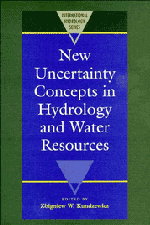Book contents
- Frontmatter
- Contents
- List of Authors
- Preface
- I INTRODUCTION
- II FACETS OF UNCERTAINTY
- III NOVEL APPROACHES TO UNCERTAINTY: FRACTALS, FUZZY SETS AND PATTERN RECOGNITION, NON-PARAMETRIC METHODS
- IV RANDOM FIELDS
- V TIME SERIES AND STOCHASTIC PROCESSES
- VI RISK, RELIABILITY AND RELATED CRITERIA
- 1 Stochastic approach to non-point pollution of surface waters
- 2 Statistically safe sets methodology for optimal management of reservoirs in risk situations
- 3 Risk assessment in control of reservoir systems
- 4 Reliability-related criteria in water supply system studies
- 5 Reliability analysis of reservoir operation
5 - Reliability analysis of reservoir operation
Published online by Cambridge University Press: 07 May 2010
- Frontmatter
- Contents
- List of Authors
- Preface
- I INTRODUCTION
- II FACETS OF UNCERTAINTY
- III NOVEL APPROACHES TO UNCERTAINTY: FRACTALS, FUZZY SETS AND PATTERN RECOGNITION, NON-PARAMETRIC METHODS
- IV RANDOM FIELDS
- V TIME SERIES AND STOCHASTIC PROCESSES
- VI RISK, RELIABILITY AND RELATED CRITERIA
- 1 Stochastic approach to non-point pollution of surface waters
- 2 Statistically safe sets methodology for optimal management of reservoirs in risk situations
- 3 Risk assessment in control of reservoir systems
- 4 Reliability-related criteria in water supply system studies
- 5 Reliability analysis of reservoir operation
Summary
ABSTRACT Optimization (mainly dynamic programming) based operation of reservoir systems has proven its superiority over traditional techniques based on the concept of rule curve, at least in terms of the selected objective function. Stochasticity of the system can be considered in the optimization by using stochastic dynamic programming to derive longterm, expectation oriented optimal policies. Since the optimality of the operation can only be realized during an infinite operational period, the performance of a stochastic system should not be characterized for practically available time series alone by the expected (annual) value of the objective function. In addition to the traditional output figures a number of performance indices (PI) can be derived to describe the operational behaviour (especially reliability) of the system upon the application of a certain operational policy. These performance indices can be estimated by simulation of the system operation according to the operational policy to be tested.
The inclusion of these PIs in the overall judgment creates a multicriterion framework for decision making. Furthermore, these performance indices are believed to be more sensitive in reflecting the impact of certain constraints than the value of the objective function alone.
The validity of this hypothesis will be tested on a multiunit multipurpose reservoir system, the Victoria, Randenigala, Rantembe reservoir cascade situated on the river Mahaweli in Sri Lanka.
Based on the results of simulation, the PIs will be analyzed for their viability in practical applications.
- Type
- Chapter
- Information
- New Uncertainty Concepts in Hydrology and Water Resources , pp. 306 - 315Publisher: Cambridge University PressPrint publication year: 1995
- 2
- Cited by

